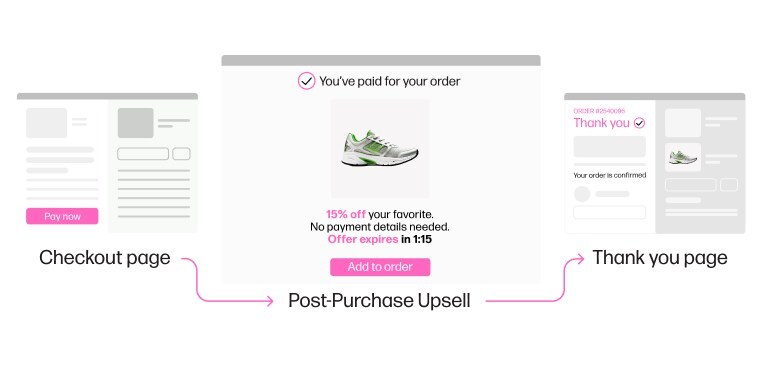Juphy’s Weekly E-Commerce News Express – 23-27 June 2025
Ceyda Duz
Welcome to this week’s e-commerce & AI highlights, where the digital commerce landscape continues its ongoing evolution. This edition explores key developments, covering recent shifts in market performance and evolving consumer expectations, including those around returns. We’ll also look at the expanding role of AI in customer journeys and retail operations, alongside new platform collaborations, global payment innovations, and advancements in logistics and interactive commerce. Dive in to gain valuable perspectives on the trends and insights shaping today’s dynamic digital market.

E-Commerce Returns: A Deal-Breaker and a Strategic Imperative
In online shopping, a generous return policy has transcended being a mere customer service offering to become a fundamental expectation, directly influencing purchasing decisions and brand loyalty. Recent industry research by Rithum, encompassing findings from six thousand consumers, consistently shows that nearly nine out of ten shoppers anticipate free returns as a standard. Furthermore, a significant proportion actively reviews a retailer’s return policy before making a purchase. This underscores a powerful consumer preference, as almost half of all online shoppers admit to having abandoned a retailer due to an unsatisfactory return experience. For modern e-commerce, returns are no longer a post-purchase afterthought; they are a critical lever shaping buying behavior.

The Escalating Cost of Convenience
While consumer satisfaction with return processes among favored retailers remains high, the financial burden on businesses is substantial. According to broad industry estimates, U.S. retailers reportedly bore an estimated $890 billion in return costs in the past year, representing a significant percentage of total sales. These expenses extend far beyond the initial lost sale, encompassing hidden costs such as shipping fees, labor for processing, and the erosion of profit margins.
Unpacking the Root Causes of Returns

The sheer volume of returns, with over three in five consumers making at least one in the last year, necessitates a deeper understanding of their origins. The fashion industry, in particular, faces the highest return rates, with a large majority of clothing and footwear purchases sent back. A notable factor here is the pervasive trend of deliberate overbuying, where consumers, especially younger demographics, intentionally purchase multiple items with the intent to try on and return. However, this often stems from a lack of confidence in online product descriptions. Poor fit remains the primary reason for returns, followed closely by discrepancies between product imagery or descriptions and the actual item received. This highlights a critical need for enhanced product content accuracy. Other categories experiencing high return rates, such as electronics, home goods, toys, and books, often see returns driven more by personal preference or taste rather than inherent product defects.
Despite the complexities and high costs associated with managing reverse logistics, return policies stand as one of the few elements retailers can entirely control. By proactively addressing the underlying reasons for returns, such as investing in better sizing guides or more detailed product visuals, and by thoughtfully re-evaluating return policies to align with evolving consumer expectations, businesses can transform a potential revenue drain into a strategic advantage. Effective return management can significantly protect margins, elevate customer satisfaction, and ultimately foster stronger brand loyalty in a competitive market.
AI in Retail: Smart Growth for Small Businesses
The impactful influence of Artificial Intelligence on the retail sector is undeniable, reshaping everything from customer product discovery to advertising strategies. While the rapid pace of this technological evolution might appear overwhelming and intimidating for smaller retail businesses lacking corporate budgets, AI presents a considerable opportunity. These agile enterprises can effectively use AI to seriously reduce operational costs, optimize team productivity, and engage consumers with powerful, personalized marketing. The key lies in identifying and implementing low-barrier, high-impact AI applications that enhance both efficiency and the overall customer journey.

Personalization and Efficiency at Scale
AI modifies sophisticated marketing capabilities that were once exclusive to large corporations. It allows for the creation of highly granular customer segments based on real-time behavior, moving beyond broad messaging to foster deeper, more lasting customer relationships. This precision translates directly into improved conversion rates and heightened customer satisfaction. Beyond personalized engagement, AI excels at streamlining repetitive, time-consuming tasks. Practical applications include:
- Automated Content Creation: Generating and refining product descriptions, optimizing them for search engines, and saving considerable manual effort.
- Enhanced Customer Support: Using intelligent chatbots for FAQs and basic inquiries, or maintaining dynamic help resources that empower self-service.
These uses, while not always “flashy”, offer real benefits in terms of efficiency and directly improve the customer experience.
The Rise of Intent-Driven Commerce

Looking ahead, a new paradigm known as “declarative commerce” is emerging, exemplified by advancements from leading e-commerce platforms. This approach shifts the focus from manually instructing software on specific tasks (like setting up a marketing campaign) to simply expressing a desired business outcome (e.g., “attract new customers”). The AI then directs the necessary executions autonomously. This intent-driven methodology significantly simplifies complex operations, providing a powerful advantage for time-constrained small business owners seeking results without deep technical involvement.
Building Trust in an AI-Enhanced Landscape
As AI becomes more integrated into retail operations, maintaining customer trust is paramount. Transparent implementation is crucial; consumers should be informed when AI is utilized, particularly in automated customer service interactions or personalized campaigns. Furthermore, businesses must ensure that AI-generated content precisely sticks to their established brand voice and editorial guidelines. Leading retailers are already demonstrating how AI can solve genuine customer pain points, such as precise sizing and fit recommendations, while openly communicating AI’s role, proving that clarity fosters confidence. Ultimately, AI offers small businesses unparalleled capabilities to increase loyalty, streamline product discovery, and craft seamless online experiences, often without requiring extensive technical budgets or specialized expertise.
Optimizing Conversions: Nosto’s Post-Purchase Strategy for Shopify
E-commerce merchants leveraging Shopify can now capitalize on a powerful new feature from Nosto, designed to maximize revenue immediately after a sale concludes. The newly introduced post-purchase upsell module intelligently analyzes real-time customer data—including Browse habits, past purchases, and current cart context—to present highly relevant product recommendations. These targeted offers appear on a dedicated page positioned strategically between the standard checkout and the final thank-you confirmation, providing an optimal window to enhance average order value without interrupting the initial purchase flow. This data-driven approach empowers Shopify sellers to seamlessly extend the customer journey and capture additional sales opportunities.

Streamlining Returns: Barrett and Two Boxes Partner on Reverse Logistics

In a move to enhance post-purchase operations for digital retailers, Barrett Distribution Centers, a prominent third-party logistics provider, has announced a collaboration with Two Boxes, a specialized reverse logistics technology platform. This partnership aims to deliver more flexible and efficient returns solutions for contemporary e-commerce brands, directly addressing the increasing intricacy of merchandise inspection and processing. Two Boxes was specifically chosen for its intuitive user experience, seamless integration capabilities with leading e-commerce platforms, and its user-friendly design tailored for warehouse operators, promising a more streamlined approach to managing the complex world of product returns.
Empowering China’s Retail: Bambuser Partners with Alibaba Cloud for Video Commerce
In a significant move to expand interactive digital retail, Bambuser, a video commerce solutions company, is collaborating with Alibaba Cloud to introduce its shoppable video capabilities into the vast Chinese market. This alliance will allow Alibaba Cloud’s clients to access a comprehensive suite of video commerce tools, encompassing live shopping experiences, integrated chat functionalities, and digital clienteling features. This strategic offering aims to provide businesses operating within China with enhanced autonomy and control over their video-driven sales initiatives, directly catering to the unique demands and immense potential of the region’s e-commerce landscape.

How Juphy AI Reduces Returns and Strengthens Customer Trust
As return rates climb and post-purchase experiences take center stage, Juphy AI helps Shopify merchants tackle both sides of the equation. First, with real-time product Q&A, customers can ask about sizing, materials, or specs before buying—reducing uncertainty and lowering return rates caused by poor fit or mismatched expectations.
Second, Juphy AI enhances transparency with built-in order tracking, offering customers instant updates on shipping status. This minimizes “Where is my order?” questions and builds confidence in your brand through a more reliable and reassuring experience.
Fewer returns. Fewer support tickets. Happier customers. Try Juphy AI today and turn uncertainty into satisfaction—from product page to delivery.

Key Takeaways
Returns: A Deal-Breaker for Online Shoppers: Nearly 9 in 10 shoppers expect free returns, and almost half have abandoned a purchase due to an unsatisfactory return policy. For consumers, return flexibility is a deciding factor—not a bonus. Brands must treat return experiences as a key loyalty and conversion driver.
AI for Retail: Smart Growth for Small Shops: AI is giving small businesses access to advanced tools that were once exclusive to major players. From generating SEO-friendly product descriptions to handling repetitive support inquiries, these tools cut costs while enhancing the customer journey.
Nosto’s Post-Purchase Upsell for Shopify: Nosto’s new feature inserts targeted product offers between checkout and the thank-you page—using live cart and browsing data. This smart timing captures the shopper’s momentum without adding friction, helping Shopify merchants raise average order value while improving the experience.
Smarter Returns: Barrett x Two Boxes: To tackle rising return complexity, Barrett Distribution and Two Boxes have launched a streamlined reverse logistics solution. Their platform integrates directly with e-commerce tools and simplifies warehouse processing—delivering speed, transparency, and lower operational friction.
Bambuser x Alibaba Cloud: Bambuser’s partnership with Alibaba Cloud brings interactive video commerce to China’s booming retail market. Retailers gain tools for live shopping, in-video chat, and digital clienteling—features now critical to engaging mobile-first audiences across Asia.

